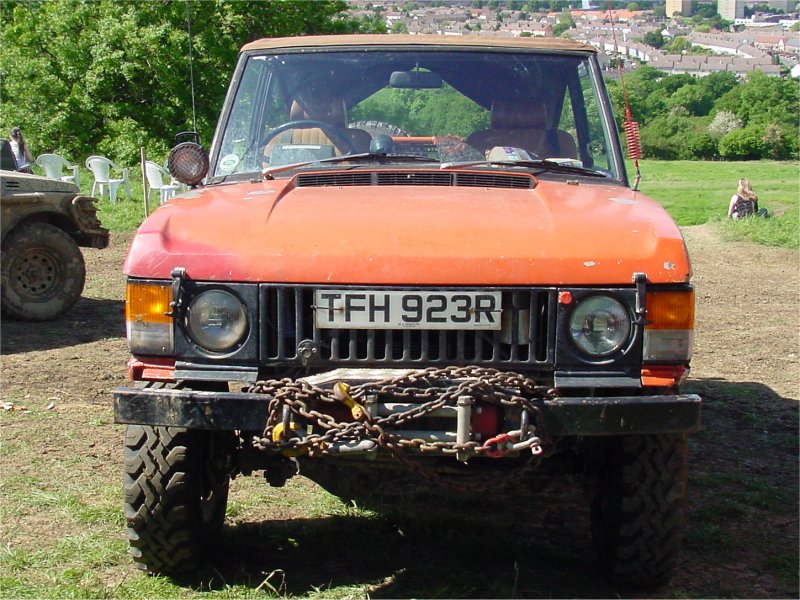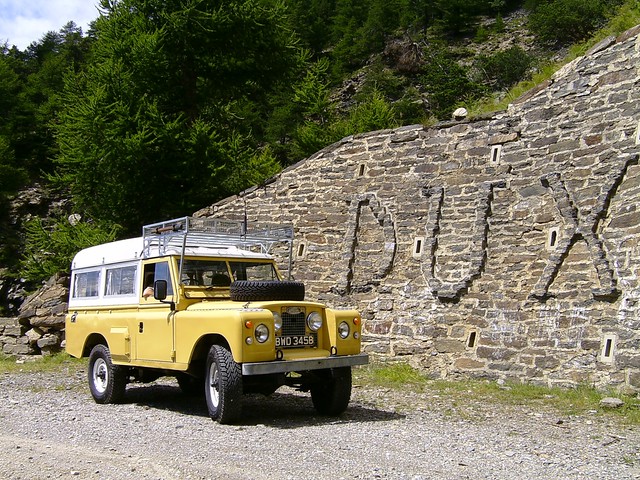FlyingPete
Well-Known Member
- Posts
- 1,305
- Location
- Coventry
There's a lot of misinformation passed around from various places about what you can and can't fit to your vehicle in the way of lighting. The main source for what is in fact allowed is the 1989 Road Vehicle Lighting Regulations. This is fairly long-winded as it covers any type of vehicle, so what I've tried to do is to pick out the relevant bits for most Landy owners, who are usually looking to add more forward-facing lights.
The legislation is split between obligatory and optional lights. In general, we'll be dealing with optional lights, since the car comes from the factory with all the obligatory ones satisfied. Optional ones are generally less restrictive compared to the obligatory ones.
For a passenger car (including all land rovers) the bare minimum you must have at the front are:
Two dipped beam headlamps
Two main beam headlamps (which may be part of the same housing as the dipped beams)
Two front position marker lights (side lights)
Headlights can be white or yellow (as fitted to all French cars before 1993.) Position lights must be white, unless they are part of a headlamp with a yellow lens.
Spotlights/driving lights
These come under 'optional main beam headlamps'. Simply put, you can fit as many of these as you like as long as they can only come on with the obligatory main beams, and are wired to switch off when you go to dipped headlamps. You can fit a switch inline to turn them off completely. The only other requirements are colour (white or yellow) and being able to adjust the aim. On a post-1991 vehicle, the lights must also be E-marked.
Roof-mounted lights are entirely legal as there is no restriction on main beam positioning. Even asymmetrical arrangements (including a single light) are also permitted.


Additional Dipped Beams
What you can do here depends on the age of the vehicle. Pre-1991 vehicles can have as many as you like. You have to comply with vertical height limits (1200mm maximum) alignment (should not be an issue with off-the-shelf parts) colour (white or yellow) and aim adjustment. A matched pair have to be switched to come on together. So for example, on a Series 2a with the headlights in the wings, you could fit a duplicate set in the grille panel and have four dipped beam and four main beam lights.

Post-1991 the situation is a bit different. You are allowed to fit one extra pair of dipped beams that are meant for driving on the right. These must be switched so that you have either the standard dipped beams or the LHD-spec ones, but not both. The idea with this is for touring abroad, where you could swap the handedness of your lights when you cross the channel. If you're using standard parts with main beam outputs as well, the main beams are of course legal at any time.
Front position lights (side lights)
These are simple. You can have as many as you like. They must be white in colour, unless they're part of a headlamp that only shows yellow. So if your roof-mounted main beams have a white position light built in, you can wire these up.
Fog lights
You can fit any number pre-1991, or up to two post-1991. The alignment needs to be set to 3% down (compared to 1.3-2% down for dipped beams.) Vertical height can't be more than 1200mm. On most land rovers, this will mean they will be mounted low down on the bodywork.The only other positioning requirement is if they're used instead of dipped beam headlamps, in which case maximum from the side of the vehicle is 400mm.
Lights used off road only
Any light which isn't used on the road is not covered by the lighting regulations. You can fit whatever you like, just don't use them on the public road.
Some other observations
The common assumption is that the maximum power limit for bulbs is the 'standard' 60/55W. The 1989 regulations don't actually list any maximum power restriction, but they do state a minimum in some cases. This would appear to mean that 100/90W bulbs are in fact legal as long as they are aligned correctly. Obviously, the wiring and headlamp assembly must be up to the job. That said, most Landy owners would prefer to fit more lights rather than brighter lights
Work lights are mentioned in the legislation about when you can use them- it's an exception to the rule of only red light being permitted at the rear (in this case as long as it's white and used while stationary to illuminate a work site.) There is however nothing specific about what a work light actually is. Common sense would appear to apply.
The full text of the regulations can be found here for reference: http://www.legislation.gov.uk/uksi/1989/1796/contents/made
If you're in any doubt about fitting something, check the regulations for yourself before going ahead.
The legislation is split between obligatory and optional lights. In general, we'll be dealing with optional lights, since the car comes from the factory with all the obligatory ones satisfied. Optional ones are generally less restrictive compared to the obligatory ones.
For a passenger car (including all land rovers) the bare minimum you must have at the front are:
Two dipped beam headlamps
Two main beam headlamps (which may be part of the same housing as the dipped beams)
Two front position marker lights (side lights)
Headlights can be white or yellow (as fitted to all French cars before 1993.) Position lights must be white, unless they are part of a headlamp with a yellow lens.
Spotlights/driving lights
These come under 'optional main beam headlamps'. Simply put, you can fit as many of these as you like as long as they can only come on with the obligatory main beams, and are wired to switch off when you go to dipped headlamps. You can fit a switch inline to turn them off completely. The only other requirements are colour (white or yellow) and being able to adjust the aim. On a post-1991 vehicle, the lights must also be E-marked.
Roof-mounted lights are entirely legal as there is no restriction on main beam positioning. Even asymmetrical arrangements (including a single light) are also permitted.

Requirements Relating to Optional Main-beam Headlamps
Any number may be fitted and the only requirements prescribed by these Regulations in respect of any which are fitted are those specified in paragraphs 7, 10 and 12(a) of Part I and, in the case of a motor vehicle first used on or after 1st April 1991, paragraph 5 of Part I.
Additional Dipped Beams
What you can do here depends on the age of the vehicle. Pre-1991 vehicles can have as many as you like. You have to comply with vertical height limits (1200mm maximum) alignment (should not be an issue with off-the-shelf parts) colour (white or yellow) and aim adjustment. A matched pair have to be switched to come on together. So for example, on a Series 2a with the headlights in the wings, you could fit a duplicate set in the grille panel and have four dipped beam and four main beam lights.

Post-1991 the situation is a bit different. You are allowed to fit one extra pair of dipped beams that are meant for driving on the right. These must be switched so that you have either the standard dipped beams or the LHD-spec ones, but not both. The idea with this is for touring abroad, where you could swap the handedness of your lights when you cross the channel. If you're using standard parts with main beam outputs as well, the main beams are of course legal at any time.
Requirements relating to optional dipped-beam headlamps
1. In the case of a vehicle with three or more wheels having a maximum speed exceeding 25 mph first used on or after 1st April 1991, two and not more than two may be fitted and the only requirements prescribed by these Regulations in respect of any which are fitted are–
(a)those specified in paragraphs 2(c), 4, 7, 10 and 12(a) of Part I,
(b)that they are designed for a vehicle which is intended to be driven on the right-hand side of the road,
(c)that they form a matched pair, and
(d)that their electrical connections are such that not more than one pair of dipped-beam headlamps is capable of being illuminated at a time.
2. In the case of any other vehicle, any number may be fitted and the only requirements prescribed by these Regulations in respect of any which are fitted are those specified in paragraphs 2(c), 4, 7 and 12(a) of Part I.
Front position lights (side lights)
These are simple. You can have as many as you like. They must be white in colour, unless they're part of a headlamp that only shows yellow. So if your roof-mounted main beams have a white position light built in, you can wire these up.
Requirements relating to optional front position lamps
1. In the case of a solo motor bicycle first used on or after 1st April 1991 which is not fitted with any obligatory front position lamp, not more than two may be fitted which must comply with the requirement specified in paragraph 7 of Part I. Where two are fitted these shall be situated as close together as possible.
2. In the case of a solo motor bicycle first used on or after 1st April 1991 which is fitted with one obligatory front position lamp, not more than one additional lamp may be fitted which must comply with the requirement specified in paragraph 7 of Part I and shall be situated as close as possible to the obligatory front position lamp.
3. In the case of any other vehicle the only requirement prescribed by these Regulations in respect of any which are fitted is that in paragraph 7 of Part I.
Fog lights
You can fit any number pre-1991, or up to two post-1991. The alignment needs to be set to 3% down (compared to 1.3-2% down for dipped beams.) Vertical height can't be more than 1200mm. On most land rovers, this will mean they will be mounted low down on the bodywork.The only other positioning requirement is if they're used instead of dipped beam headlamps, in which case maximum from the side of the vehicle is 400mm.
Lights used off road only
Any light which isn't used on the road is not covered by the lighting regulations. You can fit whatever you like, just don't use them on the public road.
Some other observations
The common assumption is that the maximum power limit for bulbs is the 'standard' 60/55W. The 1989 regulations don't actually list any maximum power restriction, but they do state a minimum in some cases. This would appear to mean that 100/90W bulbs are in fact legal as long as they are aligned correctly. Obviously, the wiring and headlamp assembly must be up to the job. That said, most Landy owners would prefer to fit more lights rather than brighter lights
Work lights are mentioned in the legislation about when you can use them- it's an exception to the rule of only red light being permitted at the rear (in this case as long as it's white and used while stationary to illuminate a work site.) There is however nothing specific about what a work light actually is. Common sense would appear to apply.
The full text of the regulations can be found here for reference: http://www.legislation.gov.uk/uksi/1989/1796/contents/made
If you're in any doubt about fitting something, check the regulations for yourself before going ahead.
Last edited:
